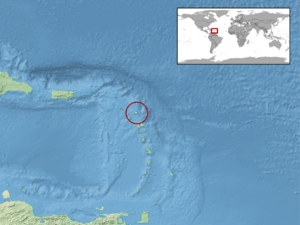Antiguan racer facts for kids
Quick facts for kids Antiguan racer |
|
|---|---|
 |
|
| Conservation status | |
| Scientific classification | |
| Genus: |
Alsophis
|
| Species: |
antiguae
|
 |
|
The Antiguan racer (Alsophis antiguae) is a harmless, brownish-grey snake. It used to live only on Great Bird Island near Antigua in the Caribbean. This snake is one of the rarest snakes in the world. In 1995, only about 50 Antiguan racers were left. But thanks to amazing conservation work, their numbers have grown to over 1,100! This was done by removing animals that hunted them and moving some snakes to other islands where they used to live. Now, you can find them on Rabbit Island, Green Island, and York Island too.
Contents
About the Antiguan Racer
The Antiguan racer is a type of snake. It belongs to a large snake family called Dipsadinae. This family includes about half of all known snake species! The Antiguan racer is part of a group called Alsophis. This group has several types of "racers" found in the West Indies. Sadly, many of these West Indian racers are now rare or have completely disappeared.
What Does the Antiguan Racer Look Like?
Antiguan racers look a bit different depending on if they are male or female. This is called sexual dimorphism.
- Adult racers are usually about 1 meter (3 feet) long.
- Females are bigger than males.
- Young males are often dark brown with light cream spots.
- Young females are silvery-grey with light brown patches.
- Females also have bigger heads than males.
- Older snakes, both male and female, can have many different colors. They might be speckled or blotchy with white, tan, reddish-brown, brown, or black.
Where Do Antiguan Racers Live?
Antiguan racers once lived all over Antigua and Barbuda. They probably lived on all the islands around Antigua. By 1995, they could only be found on Great Bird Island. This island is very small, only about 8.4 hectares (20 acres). It is located 2.5 kilometers (1.5 miles) off the northeast coast of Antigua.
Antiguan Racer Habitat
These snakes like to live in shady forests. They prefer places with lots of thick plants on the ground. You can also find them on sandy beaches and rocky areas.
Antiguan Racer Behavior
The Antiguan racer is not harmful to humans. It has a very calm and gentle nature.
- It is active during the day, from when the sun rises until it sets. This is called being diurnal.
- At night, it rests and hides in a safe spot.
- The racer seems to get sick easily from common snake mites. These mites are not naturally found in Antigua. This has made it hard to try and breed them in zoos.
What Do Antiguan Racers Eat?
The Antiguan racer mainly eats lizards. Its favorite food is the local Antiguan ground lizard. Sometimes, the snake will hunt for its food. But usually, it is an ambush predator. This means it waits quietly for its prey. It often hides most of its body under leaves, waiting for a lizard to come by.
Saving the Antiguan Racer
Hundreds of years ago, before Europeans came to Antigua, there were many Antiguan racers. The islands were covered in thick forests. These forests were full of lizards, which the snakes loved to eat. The racer also had no natural enemies.
Why the Snakes Disappeared
In the late 1400s, European settlers started to live in Antigua and Barbuda. They began to grow huge plantations of sugarcane. Ships coming to the islands brought rats with them. These rats ate the sugarcane and also the eggs of the Antiguan racer. The number of rats grew very quickly.
To get rid of the rats, plantation owners brought Asian mongooses to the islands. But they didn't know that black rats (Rattus rattus) are mostly active at night. Mongooses prefer to hunt during the day. So, the mongooses didn't catch many rats. Instead, they hunted the native birds, frogs, lizards, and Antiguan racers. Within 60 years, the snake had completely disappeared from Antigua and most of its nearby islands. Many people thought it was extinct.
The Comeback Story
Luckily, a few Antiguan racers survived on a tiny island called Great Bird Island. This island had no mongooses. In 1995, a group of scientists found only about 50 snakes left.
Conservation groups quickly started working to save them.
- First, they removed the rats from Great Bird Island. This helped the racers a lot.
- In 1996, five adult racers were sent to Jersey Zoo to try and breed them. The female snakes laid 11 eggs, and five hatched. But the snakes were hard to keep in captivity. They had special eating habits and got sick easily. Nine out of ten captive racers died from snake mites.
However, removing rats and mongooses from Great Bird Island helped the snake population there double in just two years! But then, about 20% of the snakes became too thin. There weren't enough lizards for all of them to eat. So, efforts began to clear other islands near Antigua of rats and mongooses. The goal was to move some snakes there so the population could keep growing.
Antiguan racers have now been successfully moved to:
- Rabbit Island (in 1999)
- Green Island (in 2001)
- York Island (in 2008)
Thanks to all this hard work, the total number of Antiguan racers has grown to over 1,000!
Current Challenges
Even with this success, the Antiguan racer still faces threats.
- Hurricanes like Hurricane Luis, Hurricane Georges, and Hurricane Irma have threatened them.
- Some people still kill them, even though it's against the law.
- Flooding and droughts can also harm them.
- Because there were so few snakes left, they have low genetic diversity. This means they are all very similar, which can make them weaker against diseases or other problems.


